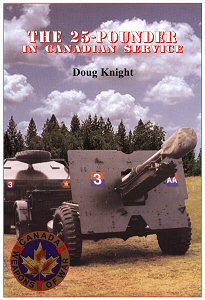 The
25-pounder in Canadian Service
The
25-pounder in Canadian Serviceby Doug Knight.
Canada's Weapons of War Series, WOW007
A5 size softback, 24 pages
ISBN: 1-894581-26-1
Service Publications,
Canada
www.servicepub.com
Review by Peter Brown
Whatever shortcomings there may have been with other British equipment in WW2, in the area of field artillery the 25pdr was a design which was world-class. Introduced in the 1930s as a combination weapon to replace the 18pdr gun and 4.5" howitzer which were the mainstays of the Great War, it was initially often called the "gun-howitzer" or "gun-how". Unlike some dual-purpose weapons, the 25pdr fulfilled the direct-fire role of gun and over-the-hill engagement of the howitzer very well. As to criticism of the design, I know of none and if there was any cause for concern it was that guns were simply not there or that there were not enough of them at any one time or place.
Early guns were converted from older 18pdr barrels on late-type carriages adapted from the original horse draft to pneumatic tyres for vehicle towing. These served in France in 1940 where many were lost or left behind - though not all, as the book relates at one point. The definitive "Ordnance QF 25pdr Mk I" was in fact a Mk II gun on a Mk I carriage, this served in all other campaigns in British and Commonwealth service. So good was the basic concept and design that only minor changes were introduced, these being mostly manufacturing improvements. Some specialist types were developed, such as the Australian "Baby 25pdr" which could be easily dismantled and carried by mule and the lightened airborne version, but apart from the addition of a muzzle brake and related counterweight to reduce recoil when firing the later high-velocity ammunition, there were few changes between the first guns and those finally phased out. In fact, some guns have survived even into the new Millennium, and as long as there is ammunition for them they will continue to give a good account of themselves.
While it is a British design, not all of them were British built and this book is the story of the gun from a Canadian viewpoint. It describes its manufacture in Canada and its use - whether British or Canadian built - in Canadian service from those sent to France and brought back at the end of the 1940 campaign, though training and in action in the Mediterranean and North West Europe. The account gives us a lot of information without being either long-winded or too brief, and is illustrated with photos of guns in service in a variety of locations including Korea. It also covers Canadian versions, the Mk III carriage with its hinged trail was one of their developments, though their other main contribution, the Sexton self-propelled version is only mentioned as a separate book is due out on that. Some unusual versions are covered, such as a mobile pillbox and a armoured version on a six-wheeled truck, as well as showing the guns being fired from landing craft and carried in a DUKW.
Almost as important as the guns are the towing vehicles and ammunition. Photos show the Canadian Military Pattern Field Artillery Tractors (CMP FATs for those into TLAs) and a side-view plan illustrate these. The two-wheeled ammunition limber is also shown, the different natures of rounds are described and though not illustrated separately they appear in several of the photos.
As a one-stop short account of this long-lived and well-loved gun - well, those who used it liked it, those it was used against might use another emotion - this has a lot to offer and deserves a place on the modeller's bookshelf whether that are interested in its Canadian use or more generally.
Thanks to Clive Law at Service Publications for the review book.
